SEO Case Study: How Sproutbox Increased Their Client Successes While Saving Time+Money
SEO Case Study: How Sproutbox Increased Their Client Successes While Saving Time + Money Sproutbox,
Home » The 3 Step SEO Backlink Strategy That Works Like Magic in 2020

SEO Case Study: How Sproutbox Increased Their Client Successes While Saving Time + Money Sproutbox,
How a Technical SEO Audit Can Boost Your Business Ever feel like you’re doing everything
This backlinking strategy is based on my own research, my own experience of optimizing over 350 websites in the last 15 years and research from other top SEO guys like Brian Dean and Nathan Gotch.
But most importantly it is based on the success both I and hundreds of our users at SEOJet have been having as they follow this link building system.
I have used this system to get top 10 rankings for almost every single key phrase I was targeting in a very short timeframe, with a brand new website, GuestPostTracker.com (a site I recently sold).
I will reference Guest Post Tracker often in this guide to show you how I implemented exactly what I am teaching. I will also show you how I have implemented these strategies on SEOJet (which is an even newer site) with much success.
BONUS: Get this SEO Strategy in PDF form
Download the PDF for this SEO strategy and we’ll send you our free SEO course that takes this strategy to the next level.
Before I get into the strategy you need a brief overview of what SEOJet is.
SEOJet is backlink management software that helps you build a #1 ranked backlink profile really fast using proven data from Google.
The software literally tells you what anchor text to use for every link so that your backlink profile always looks natural to Google.
This allows you to build links with confidence. No more guessing at which anchor text to use. No more holding back because you’re scared your backlinks might hurt your rankings. All of your backlinks move the needle. Managing your backlinks has never been so easy.
You’ll notice that I am calling this a backlink strategy, and not a generic SEO strategy. This is because this guide will mostly be focused on link building because that is what SEOJet will help you with and because that is the most important part of SEO in spite of what other “pros” try to tell you.
Before I get into the meat of the methodology, you need to know that I am teaching you this strategy under a few assumptions.
First Assumption: When you build links you will focus on getting backlinks from relevant websites that are trusted by Google. In other words, you will get links from blogs that have their own organic rankings and traffic. Or at least these blogs will be on their way to rankings and traffic.
Second Assumption: You understand how important link building is and you make it the main focus of your SEO efforts. You also know a good mix of links from websites of various authority will have the biggest impact on your rankings, especially links from relevant sites.
Third Assumption: You understand that in order to build a natural link profile, you can’t just build links to your home page. You must build links to other pages in your site as well.
Now that we’re on the same page, let’s get started with the 3 steps to crush your SEO campaign.
When you do SEO for the homepage you should only use that page to build brand trust with Google.
In other words, you want Google to look at your brand (or your client’s brand) just like it looks at Amazon, Apple, Wikipedia, Microsoft, etc.
Google has 100% trust for big brands and because of this big brands do great in the search results and are basically immune from Google updates.
So how do you get Google to trust your brand like they trust big brands? Through your homepage link building.
First off, you want to avoid targeting key phrases in your link building most of the time to your homepage. However, your on-page SEO can contain key phrases.
If you look at Amazon’s homepage backlink profile, of the 61,000+ referring domains, 90%+ of their backlinks contain one of these as their anchor:
“Amazon” “Amazon.com” “https://www.amazon.com”
That is how you get Google to trust you as a brand.
So as you build links to your homepage, 90%-95% of your backlinks are either branded anchors or some form of URL as the anchor text (https://seojet.net, SEOJet.net etc).
It is all about creating a branded presence online.
You very rarely will get any links to your homepage with key phrases in the anchor unless there is a key phrase in the brand name like “SEO” in SEOJet. I save the real key phrase targeting for my SEO power pages (more on power pages in step 2).
You must establish good brand trust with Google. You do this by getting links early and often to your homepage using the percentages I have listed above.
Many SEO’s want to know how to use their brand name naturally in a sentence when they are guest posting. The easiest way to do this is to quote yourself, or your CEO in a sentence.
For example, Adam White founder of SEOJet says that quoting yourself is an easy way to work your brand name into a sentence for a link.
See how easy that is, and how natural it looks. You can use this same strategy for URL anchors as well. (ie Adam White from SEOJet.net)
You need to be getting these branded links all the time, just like the big brands online naturally get branded links all the time.
When I built SEOJet I built the homepage link maps to help you build brand trust. If you just follow the link maps in SEOJet for your home page it will guide you to the right percentages and you will have a super-trusted site with Google.
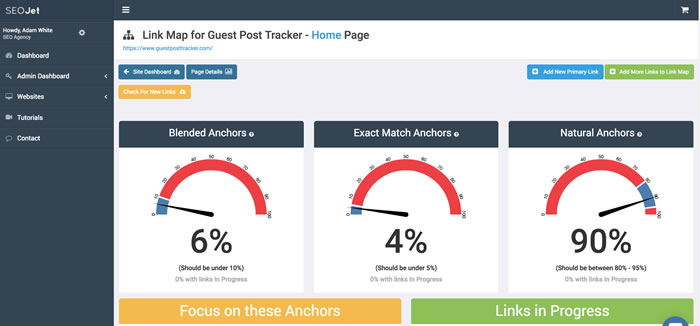
You can see from the example in the image above that with Guest Post Tracker, 90% of my homepage links had either my brand name, or some form of my URL as the anchor text. This allowed me to build brand trust and then get my other pages ranked very quickly.
Your homepage should have the most links pointing to it of any page of your site and a good metric to shoot for is for your homepage to have close to double the amount of links as the next highest page.
What is as SEO power page?
A power page is a page or blog post on your website that is amazing content. It’s the kind of content that when your target audience reads it they feel the need to comment, share or even thank you for it.
The content not only has to be great, and super helpful, but it also needs to be content that is long and in-depth. I’m talking at least 2000 words minimum. One of the power pages on Guest Post Trackers’s blog is over 10,000 words long (and ranks #1 for its biggest key phrase).
Google LOVES in-depth long-form content.
Gone are the days where you need to write a new 500-word blog post 3 times a week. With SEOJet, I have only written about 10-15 blog posts in 2 years. I just make sure that the posts are amazing.
Here is a good example of a power page on SEOJet’s blog: SEO Link Strategy For Killer Anchor Text Distribution Using Backlink Research. This power page is 6000+ words and has over 80 comments. It is targeting some big SEO related terms and continues to move up the rankings.
One of the most important things to remember when you are creating power pages for your site is you need to start with 1-3 key phrases in mind to write the content around. For example, I wrote a blog post about how to do homepage SEO the right way and I targeted the key phrase “homepage SEO” as my main key phrase.
Choosing key phrases that your target audience is searching is especially important as you start to build links to your power pages.
Once you have published this awesome content you need to move on to the third and final step of the backlinking strategy and start building backlinks to the power page like crazy.
When I say like crazy I mean you will start to actively and consistently link build for the page using a proven plan. I don’t mean that you should get a thousand spammy links to the page.
SEOJet builds out link maps specifically meant for power pages that will tell which anchor text to use for every single link and guide you through the process so your link profile is super-organic. You will be amazed as the rankings increase as you build out the link map.
Another cool feature of SEOJet is that once you have built your power page and added it into SEOJet, the software will check the top 10 rankings for the key phrase you are targeting…
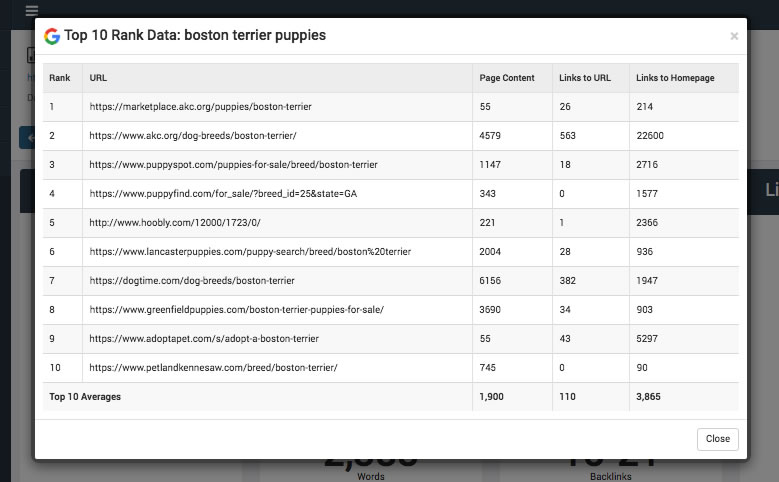
…and give you a target range of backlinks you’ll need to get the page to the top 10 on Google:
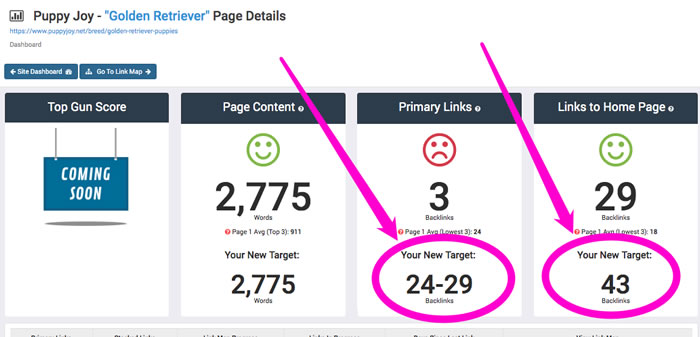
So you can quickly know how many links you will realistically need to get your power page onto the first page of Google.
One of the power pages I created is a guide on how much you should charge for SEO services. Since one of my main target audiences is SEO consultants I knew this key phrase would attract the right audience.
So I wrote 3,000+ words of content and started building links to the post using the SEOJet link map. You can see from the snapshot below where I rank for the 3 key phrases I am targeting on this page:
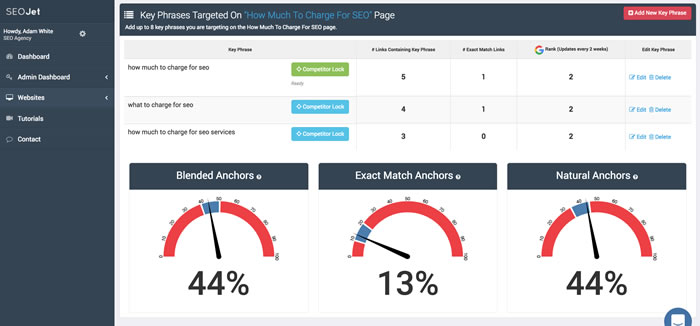
SEOJet ranks #2 for all three phrases after building only 19 links to this page. Now I understand that these aren’t the biggest phrases in the SEO niche but using the power page strategy I have been able to rank for these key phrases and take advantage of the targeted traffic it brings to my site.
Just to provide you with another example, as I mentioned before, one of the power pages I created was to target “homepage SEO”. After building about 25 links to the page using the link map built by SEOJet here are the results:
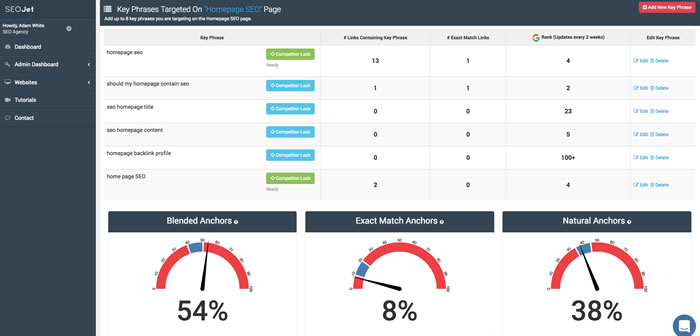
This power page ranks in the top 5 for four of the six key phrases.
Here is another snapshot of a power page I built for Guest Post Tracker that was targeting “guest post sites” and other related terms. You can see from the snapshot that 5 of the 7 key phrases rank in the top 5 of Google:
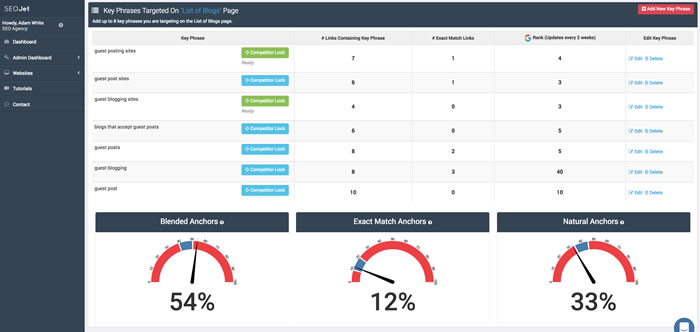
One of our users came to me and asked for me to run his link building campaign. I suggested he create a power page built around “conversion funnel optimization”. He created the power page back in March and using the link map SEOJet created we started building links to the page.
Here is the graph of his rankings for that key phrase:
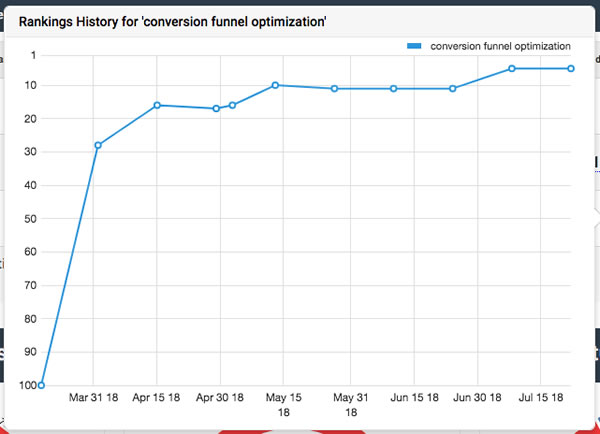
You can see how quickly a brand new blog post was able to reach the top 5 of Google using this strategy.
I’m telling you the formula is very simple and it just works. In fact, you probably came to SEOJet through one of my power pages. With power pages your link building is going to be much more focused on key phrases.
You probably noticed in the snapshots of SEOJet’s dashboard above that the software has 3 main categories of anchor text, Blended Anchors, Exact Match Anchors, and Natural Anchors. It also shows you where your backlink profile falls in each of those categories. I will give a brief explanation of each.

Blended Anchors are any anchor text that contain all or part of one of your key phrases with other words as well. They are NOT exact match anchors. For example, if I was targeting the phrase “backlink software” here are some examples of blended anchors:
“you can use backlink software to help” “this software does just that” “SEOJet has backlink software”
As you can see the anchors contain all or part of the key phrase but they also have other non-key phrase related words in the anchor as well. Google is smart enough to pull your key phrases out of anchors like this.
You’ll also notice that I wrote those anchors to be able to fit into the middle of a sentence which is really important because you want most if not all of your backlinks to be contextual and the anchors need to read naturally in a sentence.
For power pages, about 30%-40% of your backlinks to your power pages need to fall under the Blended Anchors category.
Exact Match Anchors are pretty self explanatory. Your anchor text is exactly a key phrase you are trying to rank for. (ie “backlink software”)
As far as Exact Match Anchors go you can actually have 0%-10% of your backlinks to your power pages be exact match anchors. But I wouldn’t recommend you start building any exact match anchors until you have about 15-20 links pointing to that page.
With the recent Google updates the focus for #1 ranked pages has shifted to more Natural Anchors. 55%-65% of your backlinks will fall under the Natural category and will be the same kind of branded or natural anchors you are getting on your homepage. These can also be non-keyword related terms like “click here” or “this website” or other random phrases.
I know there is a ton of SEO strategy and secret techniques on the internet but what still works and has always worked is great content supported by a natural backlink profile.
SEOJet was built to use the power page strategy. The link maps the software creates will help you build out a natural but SEO super-charged backlink profile. Step 3 – Pass SEO Juice From Power Pages To Subpages
As you build backlinks to your power pages their SEO value increases. You can pass that value to other pages (sub-pages) in your site.
You do this by internal linking to other pages in your site from the content of your power pages. Especially smaller pages where it doesn’t make sense to have a ton of content but where you are targeting important key phrases (ie product pages etc).
For example, a realtor in Orlando might have an SEO power page about how to sell 20 houses a month like clockwork. Then in that article he links out to a couple of the smaller Orlando suburb city pages in his website so he can rank for those phrases. These smaller pages I call sub-pages.
When I was doing SEO for Guest Post Tracker I had a bunch of category pages that didn’t have much content but I really needed those pages to rank. It wouldn’t have appeared natural to build a lot of links to those pages so instead, I included links out to those pages from my power pages like this:
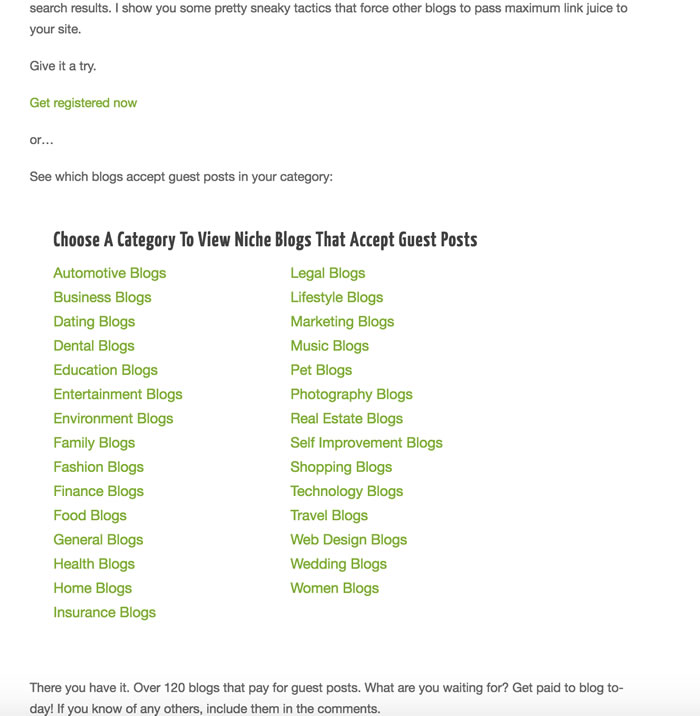
Within a few days of adding the links to the category pages my rankings on almost all of those pages shot to the top 10.
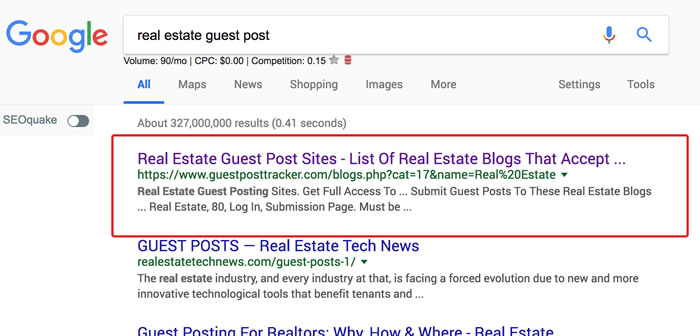
I was able to get top rankings on these category pages without having to get any external backlinks to those pages.
As you can see this SEO strategy is very dependent on a solid link building plan. So to help you get moving quickly here are some places to get links.
If you have the resources to write articles for guest posts, then I recommend you do the outreach yourself. The SEO value you get from doing your own outreach will truly pay off in the long run. You can do a simple Google search for things like:
“Keyword” “submit a guest post” “Keyword” “guest post” “Keyword” intitle:”write for us” “Keyword” intitle:”write for me” “Keyword” “guest post guidelines” “Keyword” “accepting guest posts”
These will bring back many blogs in your niche that accept guest posts.
If you are going to do your own outreach, make sure you write awesome content for these blogs. I have written really strong guest posts that now rank at the top of Google and they consistently send me traffic and sign-ups.
Guest posting hack: If you find a blog you really want to guest post on, spend some time reading other posts on that blog and even leave some meaningful comments. Sometimes I will even email the blog owner just to introduce myself or tell them how much I like their content. Then I will approach pitching them a guest post.
In other words, build a relationship with the person first and getting a guest post approved will become much easier. (On lower-traffic blogs you may not need to go through all of that to get the post placed)
HARO is one of my favorite places to get backlinks because you can get some really high-value links and it is 100% free.
I have acquired backlinks from huge sites like thriveglobal.com (da 80), fitsmallbusiness.com (da 67) and fundera.com (da 65).
Here is a list of some of my backlinks that I have acquired from HARO over the past few years:
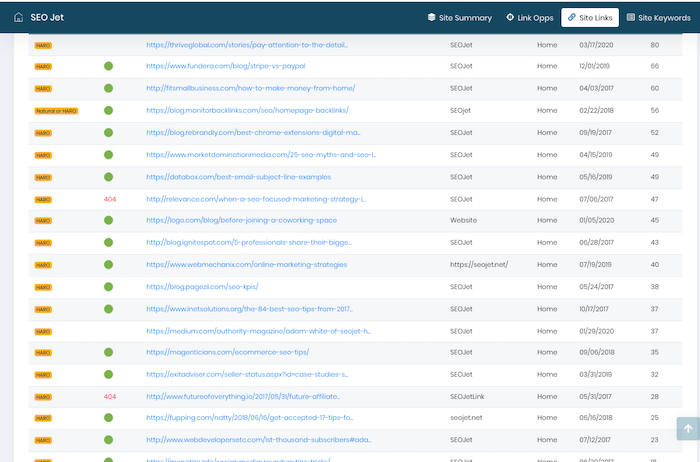
Just go to helpareporter.com and sign up to be a source. Then choose which category you want to be a source in. You will start getting emails several times a day from reporters looking for quotes.
A couple of HARO hacks:
Often times the reporter will ask a question where the response will seem really obvious to you (ie “what is the most important part of SEO?”). You have to realize that 50 other SEO pros are going to respond to that inquiry and probably give the same answer. The trick that I use to have a 70%+ success rate is that I always give a well thought out answer that I know no one else will respond with. Be original and you will be much more successful getting links from HARO.
The second hack is to be quick with your response. As soon as that email comes you should check it for any relevant inquiries. If you find one you can respond to, do it right away. The longer you wait the less likely you will get featured.
Pros: Free awesome backlinks Cons: Limited to the opportunities they send you multiplied by your success rate.
One of the sneakiest ways to beat your competitors is to go after the pages that link to them. A quick glance at a competitor’s backlink profile will reveal that many links they have are business directories you can get listed in for free, or other articles that care about linking out to the best resources and will be happy to include your site as well.
You will find that some of these website owners are SEO savvy enough to know the value of links and will want to charge you to add your backlink but it will almost always be cheaper than getting a new guest post written and placed.
SEOJet makes the process of finding and reaching out to the pages that link to your competitors extremely easy.
Just navigate to our Link Opps section and you will get a list of all pages that link to any of your competitors but don’t link to your site.
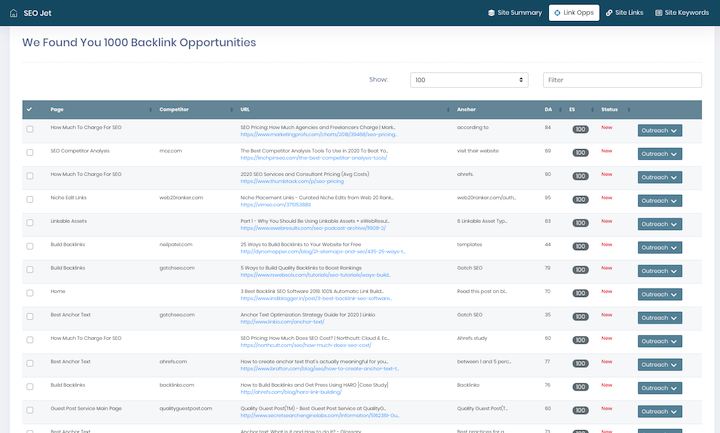
The software also includes outreach tracking tools to help you manage the entire process.
If you don’t have the time or the staff to do the blogger outreach yourself SEOJet has a premium guest posting service. We only reach out to relevant blogs that have organic rankings and traffic so we know they are trusted by Google. We make sure the guest posts look amazingly natural with links out to your site along with other authority sites and we include internal links to other pages in their blog to add to the natural appearance.
We also use our own scoring system for all blogs called JetRank that factors in Domain Authority from Moz, Domain Rating from Ahrefs, Citation Flow from Majestic, and organic traffic and rankings of the blog.
Learn more about our premium guest post service here.
You can order links directly from your link maps using the green Order This Link Now button.

When you use our service we automatically update your links maps when the links have been placed.
It is not required that you use our blogger outreach service in order to use SEOJet although it does make your life a lot easier if you do.
Other companies we have used in the past include Guest Post Solutions, Authority Builders, The Hoth and Fat Joe. Please note that none of these companies are perfect and you may not always get the best links in the world with them. But overall they seem to do a decent job.
First off let me just say that SEO’s around the globe all have a different take on how quickly they should build links to a site.
I don’t know if there is a single solution to this problem but because links are either going to cost time or money I try to stick to a budget within reason.
To my most important pages (Power Pages and Homepage) I make sure to try and get several links to these pages every month.
Sometimes links come in naturally, especially to my home page, so I don’t have to do as much proactive link building on that one.
I don’t let more than 30 days pass without getting a link to my most important power pages, but I also don’t just link to them every 30 days like clockwork. I really try to randomize when the links show up so sometimes I will do more than one at the same time. Sometimes I will do 2-3 links to a power page in a month and sometimes I will get over 10. I don’t know that the speed of the link building matters as long as the page has awesome content and the links are coming from legitimate websites.
The great thing about power pages is that if you have created some awesome content you can build a ton of links to those pages and your rankings will continue to climb, especially if the link profile follows the SEOJet link maps.
To my sub-pages I will build links to those every now and again, usually when I haven’t seen their rankings move up in a while. You need to be careful on how many links you build to sub-pages because depending on the niche you’re in, that could appear extremely unnatural.
I’d say filling out 1 link map for a subpage over the course of 1-2 years is fast enough. Let the link value come from the power pages.
Because SEOJet helps you keep your backlink profile natural, you can build links at a much faster rate than I have described here, although most websites don’t have the budget for that. The most important thing is to keep building links and keep re-establishing brand trust.
So that’s it. Three steps to use SEOJet and own the top of Google for you and your clients.
Now get out there and start building amazing #1 ranked link profiles.
Looking to supercharge your link building? Try a free trial of SEOJet for 14 days.
Or
If you haven’t already, watch an instant a demo to see how SEOJet works.